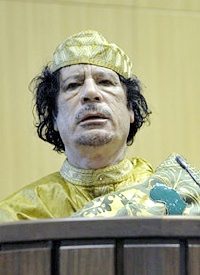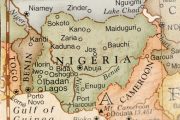
As protests enflame the Middle East, destabilizing pro-Western governments, America’s adversaries now find themselves in turmoil. Unlike protests in Egypt, Yemen, Jordan, and Albania, where Communists and socialist forces have comprised the governments there, advocates of liberty have taken to the streets in protest of the tyrannical regime of Libyan dictator Muammar Gadhafi.
Although much has been reported on the regimes of Egyptian President Hosni Mubarak and other Arab leaders at risk of losing their countries, little has been mentioned in the media about the history of Gadhafi’s reign of terror.
Unlike other leaders in the region, Gadhafi’s ties with Moscow and other enemy regimes such as Castro in Cuba and Chavez in Venezuela are much stronger and worth noting when examining the rise, and perhaps fall, of Gadhafi.
Gadhafi’s Libya as Soviet Proxy
Following the overthrow of King Idris of Libya by a military coup d’état, on September 1, 1969, Colonel Gadhafi, at the young age of 27, ascended as head of the newly declared Libyan Arab Republic.
Gadhafi, unlike Fidel Castro, who was already a self-declared Marxist-Communist before the revolution in Cuba, had yet to declare himself such.
According to Clare Sterling, in her book The Terror Network: The Secret War of International Terrorism (1981), early into his regime as 1974, Gadhafi invested his state’s oil revenues into the “neo-Fascist pro-Palestinian groups,” fearing what he saw as “Marxist encroachment in the Palestinian movement.”
The funds were dispersed via his Prime Minister Ahmed Jalloud at the “Black” Fascist and Nazi group conference held on March 9, 1974 at the Rome Hilton, in an effort to strengthen the Black or neo-Fascist forces.
By this time Gadhafi was already lending economic assistance and military support to the Marxist-Leninist PFLP led by Palestinian socialist George Habash and Argentinean Marxist-guerrilla "Carlos the Jackal," in Europe.
Gadhafi’s love affair with Fascism was largely a result of his relentless anti-Semitism, and he would later come to realize Communism was just as anti-Semitic, thus satisfying his sadistic hatred.
It “wouldn’t be long before Gadhafi himself became ‘objectively’ leftist, in left wing parlance,” according to Sterling. Following the Munich massacre, Gadhafi “donated his first $50 million to the PLO.”
Although firmly in the Fascist camp then, he justified his support of Marxist-Leninist terror groups such as the Provisional IRA, proclaiming: “We support the revolutionaries of Ireland who oppose Britain and are motivated by nationalism and religion.”
It did not matter if the proxy-state actor was Black or Red, as long as the objectives were the same and were accomplished. Both sides were financed and supported by both the Libyan camp and Soviet camp. In fact, by then, Libya was already a major recipient of arms from the Soviet Union.
Libya, serving as a conduit for the Soviet-backed guerilla insurrections throughout the third world, supplied a five-ton cargo shipment of 250 Kalashnikov rifles and additional arms to the Provisional IRA in Ireland via sea, aboard the S.S. Claudia.
The ship along with its cargo and personnel, including IRA leader Joe Cahill, was intercepted and commandeered by the Irish Navy on March 29, 1973.
Undiscouraged by that setback, Libya continued to intensify its support of Communist terrorist organizations; in November 1976, “Colonel Qaddafi of Libya and Colonel Boumedienne of Algeria agreed secretly on a joint aid program for Europe’s armed underground,” Sterling noted.
From this moment on, the Provisional IRA and the Basque nationalist ETA fell under the wing of Libya as Marxist proxies of the Soviet Union in Western Europe, Ireland, and Spain, respectively.
Without the vital Soviet arms and money, transported via Libya, the IRA and ETA would have been unable to carry out attacks, not to mention sustain themselves at the time.
Libya’s KGB Terror Camps
Aside from the European Communist underground, Libya has also been the site of the installation or various special training centers or camps, organized by the Soviet KGB.
In Terrorism: The Soviet Connection (1984), circulated by the U.S. State Department in 1986, authors Ray S. Cline and Yonah Alexander cited Akher Sa’a, an Egyptian weekly news magazine, for listing and identified the following 10 camps:
- Al-’Azizyya Camp (south of Tripoli): training the Polisario Front and international terrorists
- Al-Ma’had Camp (the name means “the institute”): training Libyan terrorists
- Al-Sa’iqa Camp (no location given; the name means “lightning bolt”): training Africans, Palestinians, Italian Red Brigades, and members of the Basque Separatists
- Al-Shahid Maqarief Camp: training Libyans
- Sebha Camp West: training terrorists
- Jaghbub Camp (at the Jaghbub or Jarabub Oasis, near Egypt): training extremist groups
- Surt Camp (at Surt or Sirte on the Gulf of Sirte): training assassins
- Tarahuna Camp (southeast of Tripoli): training extremist Arab groups
- Taybmi Camp: training extremist Tunisian groups
- Umm al-Aranib Camp (about 25 miles south of Sebha Oasis): training assassins
The debt of having the Cubans assist in the overseeing and training at these camps has not gone unpaid; Gadhafi has even given aid and support to Castro’s efforts to revolutionize Latin America along Communist lines, by assisting the Sandinista and Salvadorian Marxist guerrillas.
According to an informal briefing by the U.S. State Department on May 25, 1983, Libya was revealed to have been “providing military training for the Sandinistas and Salvadorian guerrillas,” resulting in “significant amounts of arms and training, and… numerous visits of Nicaraguan leaders to Libya.”
Terrorism: The Soviet Connection goes on to note that in 1981, “Qaddafi provided a $100-million six month deposit to the Sandinistas…”
In another stroke of bad luck like the S.S. Claudia, Brazil seized four aircraft en route from Libya to Nicaragua, loaded with stockpiles of Soviet weapons.
A similar incident occurred as recently as December 2009, when authorities in Thailand apprehended a cargo plane carrying Russian arms from North Korea to Iran.
All of this remains consistent with the policy, authorized in the Soviet Union in 1964, to increase support to terrorism by 1,000 percent, also mentioned above.
On March 22, 1987, in an interview that aired on NBC News, Gadhafi said: “Libya will in fact declare that it is a Communist country and join the Warsaw Pact and deploy Soviet missiles on the coast of the Mediterranean.”
Despite professing an ideology of “Islamic socialism,” Gadhafi never did formally declare Libya a Communist state, nor did he join the Warsaw Pact, though his willingness to do so is evident from his dedication to revolutionary world communism. Even President Reagan took notice of this, observing of Gadhafi in 1986: “We know this mad dog of the Middle East has a goal of world revolution.”
Gadhafi’s Libya as “post-Soviet” Russian Proxy
Gadhafi has not retreated from his desire to alter the world balance. In 2003, wishing to join the world’s exclusive nuclear club, Gadhafi accepted an offer by Dr. Abdul Qadeer Khan, dubbed the “father of the Islamic bomb” and described as someone who “represents the greatest nuclear proliferators in history,” to establish a uranium enrichment program for the purpose of producing a nuclear bomb, according to Paul L. Williams in his book The Al Qaeda Connection (2005).
Unfortunately again for Gadhafi, “Italian officials intercepted a shipment of centrifuge parts to Libya in October 2003,” Williams noted.
A short while after his WMD-program was foiled, Gadhafi declared his intention to abandon his nuclear program, which resulted in the United Nations lifting its sanctions against Libya.
On September 26, 2009 Reuters reported that “Venezuela’s socialist President Hugo Chavez urged colleagues from Africa and South America to help form a ‘multipolar’ world on Saturday at a summit intended to counter Western economic dominance.”
As Chavez reiterated calls for multipolarity, Gadhafi offered specifics, calling for the creation of a new collective security pact that would be a “NATO for the South” — calling it “SATO.”
Gadhafi said of this proposal: “Those who were betting on NATO, we now say to them that we’re going to bet on SATO. We’re going to have our treaty, too.”
In addition to Chavez and Gadhafi, there were representatives present from over 30 countries, including President Mugabe of Zimbabwe and President Zuma of South Africa, who also attended and gave the keynote speech at the 12th International Meeting of Communist and Workers’ Parties in South Africa, in December 2010.
In 2009, with the UN sanctions lifted, Russia announced that it would build Molniya class missile boats for Libya under a new contract. The contract, signed by Libya and Russia on March 10, 2010, is reported to be “worth up an estimated $200 million to buy three boats,” which is to be fulfilled by “Vympel shipbuilding yard in Rybinsk [in central Russia],” according to Russian news agency RIA Novosti.
In 2010, a Russian defense industry source told RIA Novosti that “A 1.3-bln euro [military-technical cooperation] deal signed between Russia and Libya this year includes the modernization of about 200 T-72 tanks which have been in service with the Libyan Army since the Soviet era.”
This article made mention of the following historical fact: “Tripoli acquired from the Soviet Union more than 2,000 tanks, 2,000 armored infantry fighting vehicles and armored personnel carriers, about 450 self-propelled artillery pieces, as well as a number of combat aircraft and large quantities of small arms since the beginning of the 1970s,” admitting that “Libya was one of the largest buyers of Russian-made armaments in the second half of the 20th century.”
In recent years Russia’s military support of its Soviet-era client Libya has returned to the same caliber as during the Cold War, by way of Russia modernizing its old Soviet hardware sold to Libya during the Cold War and through the current selling of even newer state-of-the-art hardware to Libya, including various sea, land and air units.
Regardless of Libya’s past work of doing Moscow’s bidding, there is no denying that in recent years it has not been the ideal terror-sponsoring state for the KGB, being outperformed by fellow comrade states such as the lawless regions of southern Yemen, Iran, North Korea, and Venezuela.
This change in Libyan policy was noted by the State Department under Secretary Condoleezza Rice during the Bush administration. As a result of a lack of sufficient evidence obtained by the State Department to keep it on its list of “State sponsors of terror,” President Bush had Libya removed from the list.
Under President Bush, Libya went from being America’s arch nemesis to a strategic partner in the “War on Terror.”
It should also be noted that under President Bush, U.S.-Russo relations increased under the banner of joint cooperation in the “War on Terror.”
Libya’s perceived cooperation with the West in recent years, following the fall of Saddam Hussein’s Iraq in 2003, has resulted in the emergence of an anti-Gadhafi Al Qaeda presence in Libya that has staged various attacks against the government there.
Now, as the same wave of revolutions that unseated the governments of Tunisia and Egypt makes its rounds in Libya, Libya’s former benefactor Russia remains silent with its hands, folded allowing its former ally to fall.
When one examines Libya’s past record as a Soviet proxy and key sponsor of terror, as well as its current ambiguous support of the United States and the West against Al Qaeda and international terror, it comes as no surprise that Libya’s past allies in Moscow sit idle as it collapses from within.
In essence, Libya has outlived its usefulness for Moscow; thus its fall has little to no consequence for Russia’s long-term strategic plans to destabilize the West.




